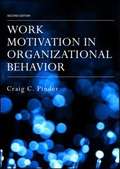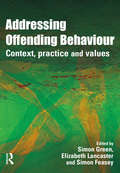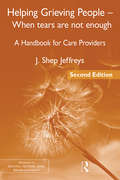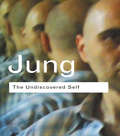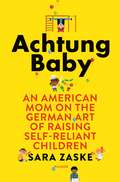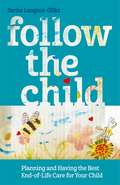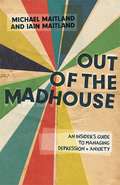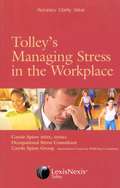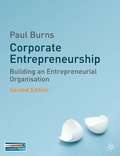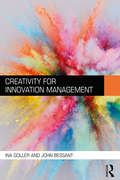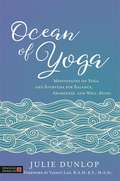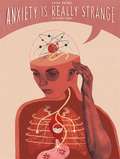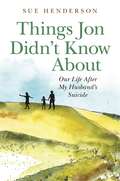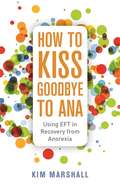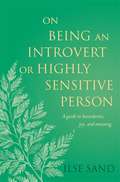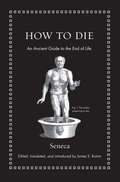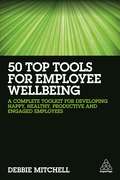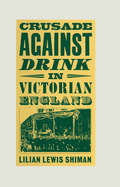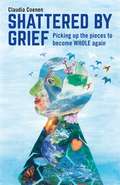- Table View
- List View
Work Motivation In Organizational Behavior (PDF)
by Craig C. PinderThis second edition of the best-selling textbook on Work Motivation in Organizational Behaviorprovides an update of the critical analysis of the scientific literature on this topic, and provides a highly integrated treatment of leading theories, including their historical roots and progression over the years. A heavy emphasis is placed on the notion that behavior in the workplace is determined by a mix of factors, many of which are not treated in texts on work motivation (such as frustration and violence, power, love, and sex). Examples from current and recent media events are numerous, and intended to illustrate concepts and issues related to work motivation, emotion, attitudes, and behavior.
Work Motivation In Organizational Behavior
by Craig C. PinderThis second edition of the best-selling textbook on Work Motivation in Organizational Behaviorprovides an update of the critical analysis of the scientific literature on this topic, and provides a highly integrated treatment of leading theories, including their historical roots and progression over the years. A heavy emphasis is placed on the notion that behavior in the workplace is determined by a mix of factors, many of which are not treated in texts on work motivation (such as frustration and violence, power, love, and sex). Examples from current and recent media events are numerous, and intended to illustrate concepts and issues related to work motivation, emotion, attitudes, and behavior.
Addressing Offending Behaviour
by Simon Green Elizabeth Lancaster Simon FeaseyThis is a comprehensive text for practitioners, researchers and academics concerned with addressing offending behaviour.
Helping Grieving People – When Tears Are Not Enough: A Handbook for Care Providers
by J. Shep JeffreysHelping Grieving People – When Tears Are Not Enough is a handbook for care providers who provide service, support and counseling to those grieving death, illness, and other losses. This book is also an excellent text for academic courses as well as for staff development training. The author addresses grief as it affects a variety of relationships and discusses different intervention and support strategies, always cognizant of individual and cultural differences in the expression and treatment of grief. Jeffreys has established a practical approach to preparing grief care providers through three basic tracks. The first track: Heart – calls for self-discovery, freeing oneself of accumulated loss in order to focus all attention on the griever. Second track: Head – emphasizes understanding the complex and dynamic phenomena of human grief. Third track: Hands – stresses the caregiver's actual intervention, and speaks to lay and professional levels of skill, as well as the various approaches for healing available. Accompanying these three motifs, the Handbook discusses the social and cultural contexts of grief as applied to various populations of grievers as well as the underlying psychological basis of human grief. Throughout the book, Jeffreys presents the role of the caregiver as an Exquisite Witness to the journey of grief and pain of bereaved family and friends, and also to the path taken by dying persons and their families. The second edition of Helping Grieving People remains true to the approach that has been so well received in the original volume. It includes updated research findings and addresses new information and developments in the field of loss, grief and bereavement.
Helping Grieving People – When Tears Are Not Enough: A Handbook for Care Providers
by J. Shep JeffreysHelping Grieving People – When Tears Are Not Enough is a handbook for care providers who provide service, support and counseling to those grieving death, illness, and other losses. This book is also an excellent text for academic courses as well as for staff development training. The author addresses grief as it affects a variety of relationships and discusses different intervention and support strategies, always cognizant of individual and cultural differences in the expression and treatment of grief. Jeffreys has established a practical approach to preparing grief care providers through three basic tracks. The first track: Heart – calls for self-discovery, freeing oneself of accumulated loss in order to focus all attention on the griever. Second track: Head – emphasizes understanding the complex and dynamic phenomena of human grief. Third track: Hands – stresses the caregiver's actual intervention, and speaks to lay and professional levels of skill, as well as the various approaches for healing available. Accompanying these three motifs, the Handbook discusses the social and cultural contexts of grief as applied to various populations of grievers as well as the underlying psychological basis of human grief. Throughout the book, Jeffreys presents the role of the caregiver as an Exquisite Witness to the journey of grief and pain of bereaved family and friends, and also to the path taken by dying persons and their families. The second edition of Helping Grieving People remains true to the approach that has been so well received in the original volume. It includes updated research findings and addresses new information and developments in the field of loss, grief and bereavement.
The Undiscovered Self: Answers to Questions Raised by the Present World Crisis
by C. G. JungIn The Undiscovered Self Jung explains the essence of his teaching for a readership unfamiliar with his ideas. He highlights the importance of individual responsibility and freedom in the context of today's mass society, and argues that individuals must organize themselves as effectively as the organized mass if they are to resist joining it. To help them achieve this he sets out his influential programme for achieving self-understanding and self-realization. The Undiscovered Self is a book that will awaken many individuals to the new life of the self that Jung visualized.
Achtung Baby: An American Mom In Berlin Learns The Art Of Raising Self-reliant Children (PDF)
by Sara Zaske Katherine EtzelAn Entertaining, Enlightening Look at the Art of Raising Self-Reliant, Independent Children Based on One American Mom's Experiences in Germany When Sara Zaske moved from Oregon to Berlin with her husband and toddler, she knew the transition would be challenging, especially when she became pregnant with her second child. She was surprised to discover that German parents give their children a great deal of freedom--much more than Americans. In Berlin, kids walk to school by themselves, ride the subway alone, cut food with sharp knives, and even play with fire. German parents did not share her fears, and their children were thriving. Was she doing the opposite of what she intended, which was toraise capable children? Why was parenting culture so different in the States? Through her own family's often funny experiences as well as interviews with other parents, teachers, and experts, Zaske shares the many unexpected parenting lessons she learned from living in Germany. Achtung Baby reveals that today's Germans know something that American parents don't (or have perhaps forgotten) about raising kids with "selbstandigkeit" (self-reliance), and provides practical examples American parents can use to give their own children the freedom they need to grow into responsible, independent adults.
Follow the Child: Planning and Having the Best End-of-Life Care for Your Child
by Sacha Langton-GilksDrawing on her family's own experiences and those of other parents facing the death of a child from illness or a life-limiting condition, Sacha Langton-Gilks explains the challenges, planning, and conversations that can be expected during this traumatic period. Practical advice such as how to work with the healthcare professionals, drawing up an Advance Care Plan, and how to move care into the home sit alongside tender observations of how such things worked in her own family's story. The book also includes a template person-centred planning document, developed by experts in the field. Empowering and reassuring, this book will help families plan and ensure the best possible end-of-life care for a child or young person.
Out of the Madhouse: An Insider's Guide to Managing Depression and Anxiety
by Iain Maitland Michael MaitlandOnce upon a time, there lived a happy family called the Maitlands. Iain, the father, was a writer. Tracey, the mother, worked at a nearby school. They had three bright and charming children, Michael, Sophie and Adam. It looked like the perfect family life. Until October 2012, when Iain received a message. Michael had been taken to hospital. Years of depression, anxiety and anorexia had taken their toll, and he had pneumonia and a collapsed lung. The doctors weren't sure if he would make it. Told with humour and frankness through Michael's diary entries and Iain's own reflections, Out of the Madhouse charts Michael's journey to recovery from entering the Priory and returning home, to becoming a mental health ambassador for young people. Sharing tips and techniques that have helped them and others to self-manage, this is an essential resource for anyone experiencing depression, anxiety, OCD and similar issues.
Managing Stress In The Workplace (PDF)
by Carole SpiersWith one in five workers reported as having felt under extreme pressure at work, stress Is overtaking the common cold as the biggest cause of absence from work. Cases such as Walker v Northumberland County Council [1995] have put stress firmly on the workplace agenda. The HSE has established stress in the workplace as a health and safety issue that needs to be recognised and managed through the use of risk assessment. Management in all organisations is now under pressure to put preventative measures in placed and to establish effective management techniques in order to tackle work-related stress. Tolley's Managing Stress in the Workplace is a practical handbook that guides the manager through their responsibilities in this difficult area. It provides clear guidelines on stress management and prevention techniques and contains useful checklists, best practice recommendations, and case studies throughout, as well as HSE guidance. Tolley's Managing Stress in the Workplace addresses the key issues that organisations face today, including: * The nature of stress and its relationship to pressure * The legal and cost implications on the organisation * Identifying the current causes and effects * Bullying and violence at work * Post-traumatic stress after a critical incident * Stress and personal health issues * Individual stress management strategies * Developing and maintaining a robust organisation Being better able to effectively handle work-related stress makes for a healthier workforce, lower absenteeism, increased performance and lower staff turnover; all of which means that having the right systems in place could save your organisation substantial costs. Tolley's Managing Stress in the Workplace is a reference manual for managers, health and safety, personnel and occupational health advisors.
Corporate Entrepreneurship: Building the Entrepreneurial Organization (PDF)
by Paul BurnsThis leading core textbook, authored by a recognised authority on the subject, covers entrepreneurial transformation in larger organizations and shows how this can be achieved by building an organizational architecture that encourages creativity, innovation and entrepreneurship. Drawing together research from a number of business disciplines and combining this with numerous corporate examples, this innovative text explains how to create an organization that fosters entrepreneurship and how an entrepreneurial organizational structure manifests itself in different industries and companies. Written in a coherent and engaging style, this book offers an accessible combination of theory and practice that encourages students to approach the subject both critically and creatively. This is an essential textbook for students studying Corporate Entrepreneurship at upper undergraduate and postgraduate level on Entrepreneurship and Business & Management degree programmes. The book also caters for students of Entrepreneurship in Engineering and Technology Management departments, and for all those studying Strategy, Innovation and Leadership.
Creativity for Innovation Management
by Ina Goller John BessantCreativity for Innovation Management is a rigorous yet applied guide which illustrates what creativity is, why it matters, and how it can be developed at both individual and group levels. Unlike many technique-oriented books, this book will combine theory and practice, drawing on the latest research in psychology, organizational behaviour, innovation and entrepreneurship. This exciting new text outlines the necessary skills and competences for innovative and creative processes. It provides opportunities to explore these and also to develop them via a wide variety of activities linked to relevant tools and techniques, as well as a range of case studies. By working through key competence areas at personal and then team levels, students then have an opportunity to practice and enhance these skills. This will be complemented by online resources which will provide students with access to key tools and techniques plus activities to help develop their creativity. This textbook is ideal for students of innovation, management and entrepreneurship, as well as professionals in those industries that want to excel by developing and applying their own creativity at work.
Ocean of Yoga: Meditations on Yoga and Ayurveda for Balance, Awareness, and Well-Being (PDF)
by Julie Dunlop MASc Vasant LadExplore the vastness of yoga through the art of meditation. This collection offers short readings on a variety of yoga-related themes, including the eight limbs, the seven chakras, and yoga's sister science, Ayurveda. Meditations for awareness and well-being are included, as well as guided relaxations and opening and closing meditations for yoga class and home practice. Weaving together the practical experience of yoga with its ancient oceanic depths, the series of meditations encourage a centering that directs attention to the breath, the present, and appreciating the gifts that each moment of life can bring. Providing nourishment for the heart, mind and body through awareness, let this book turn your attention to the essence of yoga and invite you to go within while remaining rooted in the present moment.
Anxiety is Really Strange (PDF)
by Steve Haines Sophie StandingWhat is the difference between fear and excitement and how can you tell them apart? How do the mind and body make emotions? When can anxiety be good? This science-based graphic book addresses these questions and more, revealing just how strange anxiety is, but also how to unravel its mysteries and relieve its effects. Understanding how anxiety is created by our nervous system trying to protect us, and how our fight-or-flight mechanisms can get stuck, can significantly lessen the fear experienced during anxiety attacks. In this guide, anxiety is explained in an easy-to-understand, engaging graphic format with tips and strategies to relieve its symptoms, and change the mind's habits for a more positive outlook.
Things Jon Didn’t Know About: Our Life After My Husband’s Suicide (PDF)
by Sue Henderson"Jon, my husband, took his own life at the age of 35. He left for work at 7.30, as usual. He kissed me, and our two children, as usual. He told me he loved me, which was not usual, but that didn't occur to me until later." Sue Henderson candidly recounts the experience of raising her family as a single parent survivor of suicide. Alongside an honest and moving account of the day-to-day practicalities and emotional impact of Jon's death, there's advice on how to talk to children about death and suicide, how to support them as they grow up, and how to be aware of the heightened emotional risks for bereaved children. She also draws on her experience as a social worker of 25 years to provide a theoretical framework for the book in which she discusses theories of grief and bereavement, issues of men's mental health, and the heightened incidence of male suicide.
Follow the Child: Planning and Having the Best End-of-Life Care for Your Child (PDF)
by Sacha Langton-GilksDrawing on her family's own experiences and those of other parents facing the death of a child from illness or a life-limiting condition, Sacha Langton-Gilks explains the challenges, planning, and conversations that can be expected during this traumatic period. Practical advice such as how to work with the healthcare professionals, drawing up an Advance Care Plan, and how to move care into the home sit alongside tender observations of how such things worked in her own family's story. The book also includes a template person-centred planning document, developed by experts in the field. Empowering and reassuring, this book will help families plan and ensure the best possible end-of-life care for a child or young person.
Out of the Madhouse: An Insider's Guide to Managing Depression and Anxiety
by Iain Maitland Michael MaitlandOnce upon a time, there lived a happy family called the Maitlands. Iain, the father, was a writer. Tracey, the mother, worked at a nearby school. They had three bright and charming children, Michael, Sophie and Adam. It looked like the perfect family life. Until October 2012, when Iain received a message. Michael had been taken to hospital. Years of depression, anxiety and anorexia had taken their toll, and he had pneumonia and a collapsed lung. The doctors weren't sure if he would make it. Told with humour and frankness through Michael's diary entries and Iain's own reflections, Out of the Madhouse charts Michael's journey to recovery from entering the Priory and returning home, to becoming a mental health ambassador for young people. Sharing tips and techniques that have helped them and others to self-manage, this is an essential resource for anyone experiencing depression, anxiety, OCD and similar issues.
How to Kiss Goodbye to Ana: Using Eft In Recovery From Anorexia
by Kim MarshallDo you struggle with Ana (anorexia) or have a difficult relationship with food and body image? Emotional Freedom Techniques (EFT) have the potential to transform your life and put you on the path to recovery. Here, honest diary extracts relay Kim Marshall's own struggles with anorexia and bulimia, including time spent in a residential treatment centre, and how she discovered EFT and learned to quiet the negative voices that were blocking her recovery. Now fully-recovered and a certified EFT practitioner, Kim explains how to use the approach as a self-help tool. Including easy-to-follow EFT scripts and positive mantras to help you stay on the path to recovery, Kim explains how to use EFT to help overcome denial and fears about recovery from anorexia. This candid account of recovery from eating disorders shows how it is possible to deal with underlying emotional issues and achieve a more positive mindset.
On Being an Introvert or Highly Sensitive Person: A Guide To Boundaries, Joy, And Meaning
by Ilse SandIn a culture that ranks sociability and extroversion above the introverted traits of deep thinking and being alone, Ilse Sand shows how to find joy and meaning as an introvert or highly sensitive person. She debates whether these traits are caused by nature or nurture, and shows how someone like this can organise their life to keep them content. What she says is appropriate for people who are temporarily, or for some other reason, in a sensitive situation - for example, because of stress, trauma or burn-out. It describes the introverted personality type and the highly sensitive trait, highlighting the strengths that come with it such as good listening skills and rich imagination, and suggests ways to overcome the negatives such as the need to avoid overstimulation and over-critical thinking. Including advice from other introverts or highly sensitive people, and two self-tests for sensitive and introverted traits, this book provides a deeper understanding of introversion and high sensitivity and gives those with these personality types greater faith and courage in their own talents.
How to Die: An Ancient Guide to the End of Life
by Seneca James S. RommTimeless wisdom on death and dying from the celebrated Stoic philosopher Seneca"It takes an entire lifetime to learn how to die," wrote the Roman Stoic philosopher Seneca (c. 4 BC–65 AD). He counseled readers to "study death always," and took his own advice, returning to the subject again and again in all his writings, yet he never treated it in a complete work. How to Die gathers in one volume, for the first time, Seneca's remarkable meditations on death and dying. Edited and translated by James S. Romm, How to Die reveals a provocative thinker and dazzling writer who speaks with a startling frankness about the need to accept death or even, under certain conditions, to seek it out. Seneca believed that life is only a journey toward death and that one must rehearse for death throughout life. Here, he tells us how to practice for death, how to die well, and how to understand the role of a good death in a good life. He stresses the universality of death, its importance as life's final rite of passage, and its ability to liberate us from pain, slavery, or political oppression. Featuring beautifully rendered new translations, How to Die also includes an enlightening introduction, notes, the original Latin texts, and an epilogue presenting Tacitus's description of Seneca's grim suicide.
How to Die: An Ancient Guide to the End of Life
by Seneca James S. RommTimeless wisdom on death and dying from the celebrated Stoic philosopher Seneca"It takes an entire lifetime to learn how to die," wrote the Roman Stoic philosopher Seneca (c. 4 BC–65 AD). He counseled readers to "study death always," and took his own advice, returning to the subject again and again in all his writings, yet he never treated it in a complete work. How to Die gathers in one volume, for the first time, Seneca's remarkable meditations on death and dying. Edited and translated by James S. Romm, How to Die reveals a provocative thinker and dazzling writer who speaks with a startling frankness about the need to accept death or even, under certain conditions, to seek it out. Seneca believed that life is only a journey toward death and that one must rehearse for death throughout life. Here, he tells us how to practice for death, how to die well, and how to understand the role of a good death in a good life. He stresses the universality of death, its importance as life's final rite of passage, and its ability to liberate us from pain, slavery, or political oppression. Featuring beautifully rendered new translations, How to Die also includes an enlightening introduction, notes, the original Latin texts, and an epilogue presenting Tacitus's description of Seneca's grim suicide.
50 Top Tools for Employee Wellbeing: A Complete Toolkit for Developing Happy, Healthy, Productive and Engaged Employees
by Debbie MitchellIn a world of political and economic uncertainty where stress and unhappiness are on the rise, improving employee wellbeing has never been more important. But with budgets being squeezed and the constant need to do more with less, this can seem like an insurmountable task. 50 Top Tools for Employee Wellbeing shows that interventions don't need to be expensive or time-consuming. It contains practical tools for immediately improving staff wellbeing, resulting in happier, more engaged and more productive employees. Each tool in the book includes guidance on when to use it, how to get the most out of it and - most importantly - how to measure its impact to show what's working and where efforts are best focused. Addressing all the key areas of the subject, from career development and workplace culture to physical, mental and financial wellbeing, this is a complete resource for improving your workforce's wellbeing.
50 Top Tools for Employee Wellbeing: A Complete Toolkit for Developing Happy, Healthy, Productive and Engaged Employees
by Debbie MitchellIn a world of political and economic uncertainty where stress and unhappiness are on the rise, improving employee wellbeing has never been more important. But with budgets being squeezed and the constant need to do more with less, this can seem like an insurmountable task. 50 Top Tools for Employee Wellbeing shows that interventions don't need to be expensive or time-consuming. It contains practical tools for immediately improving staff wellbeing, resulting in happier, more engaged and more productive employees. Each tool in the book includes guidance on when to use it, how to get the most out of it and - most importantly - how to measure its impact to show what's working and where efforts are best focused. Addressing all the key areas of the subject, from career development and workplace culture to physical, mental and financial wellbeing, this is a complete resource for improving your workforce's wellbeing.
Crusade Against Drink In Victorian England (PDF)
by Lilian Lewis ShimanDrink, 'the curse of Britain', was sweeping the land, or so it seemed to many Englishmen in the early decades of the nineteenth century. They held it responsible for crime, poverty and many other ills of the rapidly industrializing towns. A 'moderation' temperance reform organized in 1829 largely under middle class auspices soon gave way to a radical commitment to total abstinence in a great variety of worker self-help groups. When these too failed to change the drinking habits of most Englishmen the temperance movement sought new alliances. In the 1870s and 1880s Gospel Temperance married temperance to revivalist religion. It received the support of both established and non-conformist churches, and millions 'took the pledge'. But many did not; and as religious enthusiasm faded the anti-drink forces shifted their attention to the political arena. After successfully pressuring the Liberal Party to adopt limited prohibition, they mounted a great but unsuccessful campaign in the 1895 election. With this defeat the anti-drink crusade disintegrated, leaving the dedicated teetotallers socially isolated in the safe haven of their drink-free subculture.
Shattered by Grief: Picking up the pieces to become WHOLE again
by Claudia CoenenThis is a practical guide to help readers work through their grief via expressive therapies and activities, based on the techniques Claudia Coenen honed as a professional counselor after the unexpected loss of her husband. This book provides clear methods to process grief, experience its pain and learn how to live fully again. Readers are encouraged to completely engage with their grief through storytelling, self-care and ritual, and honest reflection. The book navigates the reader through the healing process while allowing them the freedom to explore their pain in a way that best fits their unique situation. Eschewing the idea of a 'quick-fix' to grief, it suggests ways in which tragedy and loss can be a springboard for rejuvenation and transformation.
